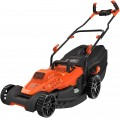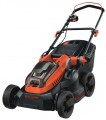Motor type
The type of engine that drives the cutting tool of the lawn mower, and in self-propelled models, the device itself. At the moment, the following types of engines are used:
— Electric (mains).
Mains powered motor. Its advantages are low noise level, low cost and ease of operation (no need to buy fuel and oil) and no emissions into the atmosphere. Among the shortcomings can be called a relatively small power and a short range, limited by the length of the power cord.
— Electric (battery). Electric motor powered by its own built-in battery. It has all the same advantages as a mains-powered motor; in addition, such devices are not limited in movement, since they do not require a network connection during operation. On the other hand, the battery life of
battery lawn mowers rarely exceeds half an hour, the battery weighs a lot and takes a long time to charge, and the power of such devices is even lower than that of network ones (despite the fact that they are noticeably more expensive).
—
Petrol. Gasoline internal combustion engine. The advantages of such engines, in comparison with electric ones, are independence from the mains connection and high power, which allows you to work with dense thick vegetation. On the other hand, gasoline engines are heavier, more expensive to run, require the purchase of fuel and lubricants, and emit exhaust gases into the
...air.
— Diesel. A type of internal combustion engine. In terms of basic features, diesel engines are almost identical to those described above, but they also have their own characteristics. On the one hand, in such units it is easier to provide high power and good torque, so they are better suited for "heavy" tasks; and diesel fuel is cheaper than gasoline. On the other hand, diesel engines themselves are more expensive, heavier and more difficult to operate. Therefore, they are not particularly popular among lawn mowers, this option is found mainly in riders (see "Type"), where high power is more important than the mentioned disadvantages.
— Gas. A rare variety of internal combustion engines that use a propane-butane mixture of gas as fuel. Their advantages over gasoline units are economical consumption, high mowing performance, and a small amount of harmful emissions into the atmosphere. In addition, gas fuel reduces the load on the engine, which, in turn, prolongs its operational life. The reverse side of the coin is the need to fill the cylinder with liquefied hydrocarbon gases at specialized filling complexes or the frequent replacement of gas cartridges.
— Without engine(manual). Lawnmowers that are not equipped with any motors and use the muscular strength of the user — when working, it is necessary to push the device in front of you. The advantages of such a scheme are low cost (both the device itself and its operation), independence from fuel and electricity, and maximum environmental friendliness; disadvantages are the relatively low quality of work and the significant expenditure of physical strength.Cutting width
The capture width provided by the unit, in other words, the width of the strip of land cultivated in one pass. In fact, this size corresponds to the width of the working nozzle.
The large working width is useful when processing large open spaces, as it allows you to finish the job in a small number of passes. On the other hand, for hard-to-reach places, relatively narrow tools are better suited, able to go where a wider unit will not fit. In addition, the width of the tool directly affects the weight and price.
In general, it makes sense to compare in terms of working width only units of the same type (see above). However, it is worth noting here that trimmers do not differ so much from each other — most models capture from 25 to 45 cm (and a wide processing band is provided by moving the nozzle from side to side). As for the other types, in the most modest models the capture width
does not exceed 40 cm, in the heaviest and most powerful it can be
56 – 60 cm or even
more(in mini tractors — up to 1.5 m).
Min. cutting height
The minimum cutting height provided by the lawnmower — that is, the smallest height of grass that can remain after the passage of the machine. It makes sense to pay attention to this indicator mainly in cases where the lawn is planned to be cut as short as possible. In addition, the lower the minimum height (with the same maximum), the wider the height adjustment range of this model.
Max. cutting height
The maximum cutting height that the lawn mower can achieve is the maximum height of grass that can be left after the machine has passed.
This parameter is relevant mainly for those cases when you want to leave the grass on the lawn relatively long. In addition,
lawn mowers with high cutting heights have a wide range of mowing adjustments.
Recommended area
The area of the site for which the lawn mower is designed. It cannot be argued that this parameter is critical when choosing a device, these are only manufacturer's recommendations and are very conditional. However, they are more than justified and generally show the available front of work based on the heating of the motor, the capacity of the tank or battery, and other factors that affect the duration of work.
Bag volume
The volume of the grass clipping bag supplied with the lawn mower. Manufacturers select this volume depending on the power, performance and overall level of the unit, however, similar models may differ in this indicator. In such cases, it is worth considering that a larger bag takes longer to fill and needs to be unloaded less often, but it weighs more and takes up more space (even when empty). Mostly the difference in the volume of the bag is 5 liters and there are
lawn mowers for 35,
40,
45,
50, 55,
60,
65,
70 and more liters.
Features
-
Self-propelled. In self-propelled lawn mowers, the engine rotates not only the cutting tool, but also the wheels of the lawn mower; thus, the user does not need to push it in front of him - it is enough just to set and control the direction of movement. This is convenient, but such models are more expensive than non-self-propelled ones. This is due not only to the complexity of the design, but also to the fact that such devices require more powerful engines - after all, power must be divided between the cutting nozzle and the chassis. For the same reason, a self-propelled unit will be less productive and efficient than a non-self-propelled analogue of the same power. However, some types of lawn mowers are by definition self-propelled - in particular, these are heavy professional models that would be difficult to push with your hands, as well as
mini tractor riders(see "Type").
-
Height adjustable handle. Possibility of height adjustment of the lawn mower handle, which allows to optimally adjust the device to the height of the user. This feature is especially useful for short or, conversely, tall people - by default, lawn mower handles are made for medium height, and it would be inconvenient to work with the unit without height adjustment.
-
Piano wheels. The lawn mower has special, so-called. caster wheels (similar to th
...ose used, for example, in supermarket carts). These wheels automatically turn in the direction of movement of the device, which significantly reduces the turning radius of the lawn mower and increases its maneuverability. At the same time, it is worth noting that this design is usually used only for the front wheels, while the rear ones remain rigidly fixed to the axle. So moving such a structure sideways still does not work.
- Flushing fitting. The presence of a fitting in the lawn mower for connecting a garden hose; usually such a fitting is located on the deck and is designed for a standard connector used in hoses. In accordance with the name, this function allows you to rinse the deck and blade of the unit, removing grass residues and other contaminants from them: just connect the hose, turn on the working nozzle and give water. This is much more convenient than removing the deck and washer blade by hand - especially when it comes to a heavy professional mower or rider (see "Type").
- Cup holder. The presence of a cup holder in the design of the lawn mower - a specialized stand for glasses and relatively small bottles. Such a stand usually has a characteristic recess where a container with a drink for the operator is installed. Often, cupholders are made in pairs, they are placed on a separate panel between the tubes of the handle of the unit. There are coasters in traditional lawn mowers and riders (mini tractors).Revolutions (electric motors)
The maximum speed that the engine in an electric mower can run at (see "Engine type").
It makes sense to compare according to this indicator only engines of the same power. In general, higher rpm improves performance but reduces torque. Conversely, a relatively slow engine will be inferior to a “fast” one in overall speed, but it will better cope with dense dense vegetation. So it’s worth choosing by engine speed, taking into account what is more important to you — speed or efficiency in difficult conditions.
Motor power
Lawnmower engine power expressed in watts. This designation is used absolutely for all electric models (see "Engine type"), and it is also often found in gasoline and diesel units along with horsepower (these units are clearly related, 1 hp is about 735 watts).
In general, the more powerful the engine, the more performant the mower and the better it will cope with heavy work such as cutting thick grass, bushes, etc. On the other hand, high power has a corresponding effect on fuel / electricity consumption, as well as the weight and price of the engine. In addition, note that the power requirements depend on the type of mower itself and its engine (see above for both). For example, for most
robots, the power
does not exceed 500 W — more, taking into account specialization, is not required, besides, otherwise the devices would turn out to be too bulky and heavy. Trimmers and lawn mowers of similar power are only electric, and the power limit for power tools is
2500 – 3000 W when powered from the mains and
1500 – 2000 W for battery models. But in gasoline tools, the minimum power is about
500 – 1000 W for trimmers and
1000 – 1500 W for mowers; the maximum value can exceed
4 kW.
Detailed recommendations for choosing a lawn mower d
...epending on its type and features of the planned work can be found in special sources.
